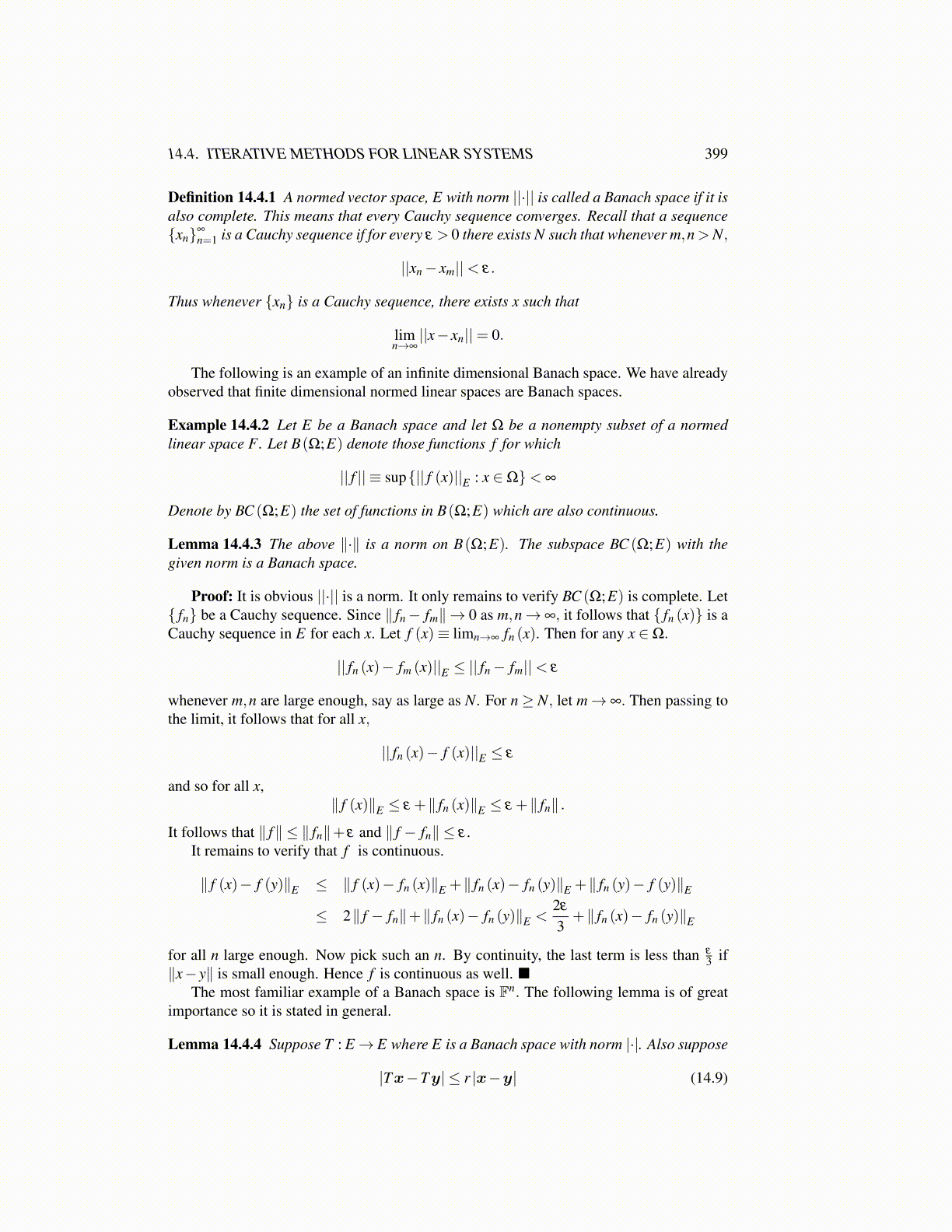
14.4. ITERATIVE METHODS FOR LINEAR SYSTEMS 399
Definition 14.4.1 A normed vector space, E with norm ||·|| is called a Banach space if it isalso complete. This means that every Cauchy sequence converges. Recall that a sequence{xn}∞
n=1 is a Cauchy sequence if for every ε > 0 there exists N such that whenever m,n>N,
||xn− xm||< ε.
Thus whenever {xn} is a Cauchy sequence, there exists x such that
limn→∞||x− xn||= 0.
The following is an example of an infinite dimensional Banach space. We have alreadyobserved that finite dimensional normed linear spaces are Banach spaces.
Example 14.4.2 Let E be a Banach space and let Ω be a nonempty subset of a normedlinear space F. Let B(Ω;E) denote those functions f for which
|| f || ≡ sup{|| f (x)||E : x ∈Ω}< ∞
Denote by BC (Ω;E) the set of functions in B(Ω;E) which are also continuous.
Lemma 14.4.3 The above ∥·∥ is a norm on B(Ω;E). The subspace BC (Ω;E) with thegiven norm is a Banach space.
Proof: It is obvious ||·|| is a norm. It only remains to verify BC (Ω;E) is complete. Let{ fn} be a Cauchy sequence. Since ∥ fn− fm∥→ 0 as m,n→ ∞, it follows that { fn (x)} is aCauchy sequence in E for each x. Let f (x)≡ limn→∞ fn (x). Then for any x ∈Ω.
|| fn (x)− fm (x)||E ≤ || fn− fm||< ε
whenever m,n are large enough, say as large as N. For n≥ N, let m→ ∞. Then passing tothe limit, it follows that for all x,
|| fn (x)− f (x)||E ≤ ε
and so for all x,∥ f (x)∥E ≤ ε +∥ fn (x)∥E ≤ ε +∥ fn∥ .
It follows that ∥ f∥ ≤ ∥ fn∥+ ε and ∥ f − fn∥ ≤ ε .It remains to verify that f is continuous.
∥ f (x)− f (y)∥E ≤ ∥ f (x)− fn (x)∥E +∥ fn (x)− fn (y)∥E +∥ fn (y)− f (y)∥E
≤ 2∥ f − fn∥+∥ fn (x)− fn (y)∥E <2ε
3+∥ fn (x)− fn (y)∥E
for all n large enough. Now pick such an n. By continuity, the last term is less than ε
3 if∥x− y∥ is small enough. Hence f is continuous as well. ■
The most familiar example of a Banach space is Fn. The following lemma is of greatimportance so it is stated in general.
Lemma 14.4.4 Suppose T : E→ E where E is a Banach space with norm |·|. Also suppose
|Tx−Ty| ≤ r |x−y| (14.9)